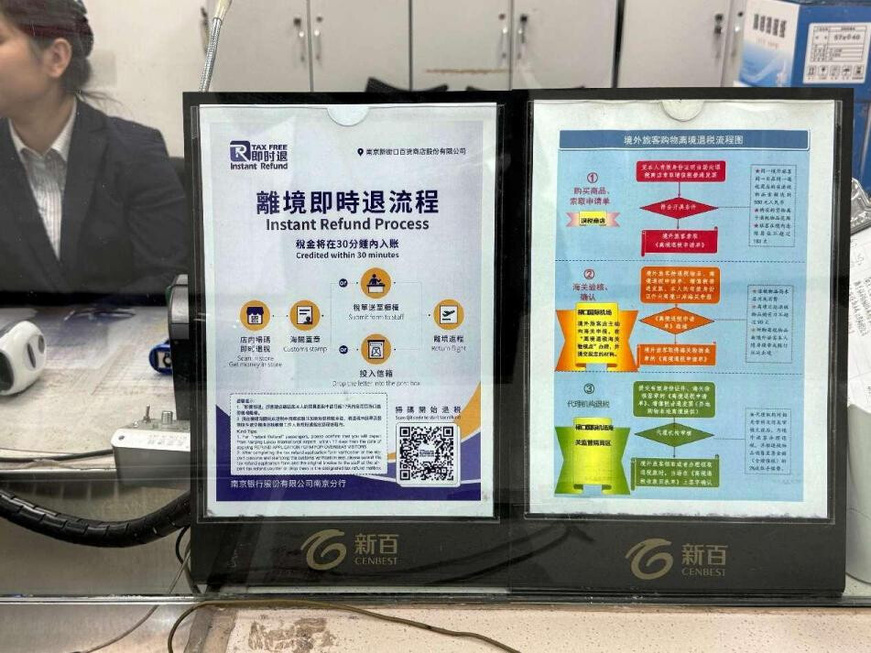By Wang Ke, People's Daily

Photo taken on April 18, 2025 shows a departure tax refund counter at the customer service center of Nanjing Xinjiekou Department Store in Nanjing, east China's Jiangsu province. (Photo by Wang Luxian/People's Daily Online)
Recently, China introduced a new package of measures aimed at further optimizing the departure tax refund policy and boosting inbound spending. The package includes eight policy measures across three areas: expanding the number of departure tax refund stores, enriching the supply of related goods, and improving related services.
Departure tax refund, which allows foreign travelers to claim back value-added tax (VAT) on goods purchased at designated tax refund stores, is already a common practice in over 50 countries and regions, including the European Union, Japan, Singapore and Australia.
In 2024, inbound travelers to China spent a total of $94.2 billion, up 77.8 percent from a year earlier. The improvement of the departure tax refund policy seeks to enhance the shopping experience for overseas travelers in China, boosting their overall satisfaction with both travel and consumption.
Expansion of tax refund store network
Despite growth, China's departure tax refund market remains in its early stage. Currently, eligible stores are concentrated in major cities such as Beijing and Shanghai, while popular tourist destinations with large numbers of international visitors often lack sufficient coverage.
`
More departure tax refund stores will be set up in major shopping areas, tourist sites, airports, and hotels. Additionally, the government supports the creation of themed shopping streets offering tax refund services, making the process more accessible for international shoppers.
To further stimulate participation, the policy has eased the requirements for store registration. Newly opened stores, operating for less than a year, can now apply for departure tax refund eligibility. The registration process, which once required approval from provincial tax authorities, will now be handled by local tax offices, with processing time reduced to within five working days.
Broader range of eligible goods
At present, international brands dominate the range of tax refund items available to foreign travelers. According to the new measures, the minimum purchase threshold for departure tax refunds has been lowered, allowing overseas travelers to apply for a refund if they spend at least 200 yuan ($27.5) at the same store on the same day and meet other relevant requirements.
Besides, departure tax refund stores are encouraged to broaden product offerings to include time-honored brands, renowned Chinese consumer goods, smart devices, intangible cultural heritage items, crafts and specialty products, among others.
Streamlining the refund process
According to the new package, efforts will be made to streamline the refund process, enhance the management system, improve invoice issuance efficiency, and reduce wait times for travelers. A series of activities to promote shopping in China will be launched to support local efforts to cultivate and promote high-quality signature products, such as "city gifts" and "must-buy" items, in departure tax refund stores.
Moreover, regions with capabilities are encouraged to adopt item sealing and coding systems, allowing customs to verify purchases without opening packages. To further enhance service delivery, tax refund agencies are encouraged to work with currency exchange counters and foreign visitor service centers in airport departure areas. Cross-regional cooperation and inter-agency coordination will also be strengthened to ensure a smooth and efficient experience for international travelers.
While ensuring proper risk management, refunds will be made available through multiple channels, including mobile payments, bank cards and cash, to better accommodate the diverse payment preferences of overseas travelers. The upper limit for cash refund has been raised to 20,000 yuan.
Currently, China refunds 11 percent of the tax-inclusive price for most goods, returning the full VAT paid by foreign visitors. With a broad range of eligible goods and an efficient refund process, the policy is expected to make China an even more attractive destination for global shoppers. These measures represent China's commitment to creating a more dynamic and accessible environment for inbound travelers.
Departure tax refund, which allows foreign travelers to claim back value-added tax (VAT) on goods purchased at designated tax refund stores, is already a common practice in over 50 countries and regions, including the European Union, Japan, Singapore and Australia.
In 2024, inbound travelers to China spent a total of $94.2 billion, up 77.8 percent from a year earlier. The improvement of the departure tax refund policy seeks to enhance the shopping experience for overseas travelers in China, boosting their overall satisfaction with both travel and consumption.
Expansion of tax refund store network
Despite growth, China's departure tax refund market remains in its early stage. Currently, eligible stores are concentrated in major cities such as Beijing and Shanghai, while popular tourist destinations with large numbers of international visitors often lack sufficient coverage.
`
More departure tax refund stores will be set up in major shopping areas, tourist sites, airports, and hotels. Additionally, the government supports the creation of themed shopping streets offering tax refund services, making the process more accessible for international shoppers.
To further stimulate participation, the policy has eased the requirements for store registration. Newly opened stores, operating for less than a year, can now apply for departure tax refund eligibility. The registration process, which once required approval from provincial tax authorities, will now be handled by local tax offices, with processing time reduced to within five working days.
Broader range of eligible goods
At present, international brands dominate the range of tax refund items available to foreign travelers. According to the new measures, the minimum purchase threshold for departure tax refunds has been lowered, allowing overseas travelers to apply for a refund if they spend at least 200 yuan ($27.5) at the same store on the same day and meet other relevant requirements.
Besides, departure tax refund stores are encouraged to broaden product offerings to include time-honored brands, renowned Chinese consumer goods, smart devices, intangible cultural heritage items, crafts and specialty products, among others.
Streamlining the refund process
According to the new package, efforts will be made to streamline the refund process, enhance the management system, improve invoice issuance efficiency, and reduce wait times for travelers. A series of activities to promote shopping in China will be launched to support local efforts to cultivate and promote high-quality signature products, such as "city gifts" and "must-buy" items, in departure tax refund stores.
Moreover, regions with capabilities are encouraged to adopt item sealing and coding systems, allowing customs to verify purchases without opening packages. To further enhance service delivery, tax refund agencies are encouraged to work with currency exchange counters and foreign visitor service centers in airport departure areas. Cross-regional cooperation and inter-agency coordination will also be strengthened to ensure a smooth and efficient experience for international travelers.
While ensuring proper risk management, refunds will be made available through multiple channels, including mobile payments, bank cards and cash, to better accommodate the diverse payment preferences of overseas travelers. The upper limit for cash refund has been raised to 20,000 yuan.
Currently, China refunds 11 percent of the tax-inclusive price for most goods, returning the full VAT paid by foreign visitors. With a broad range of eligible goods and an efficient refund process, the policy is expected to make China an even more attractive destination for global shoppers. These measures represent China's commitment to creating a more dynamic and accessible environment for inbound travelers.
 Menu
Menu
 China enhances departure tax refund policies to boost inbound spending
China enhances departure tax refund policies to boost inbound spending
















